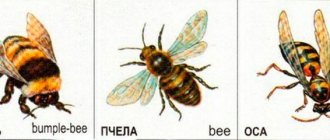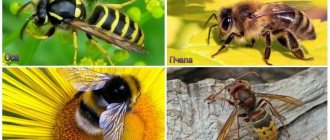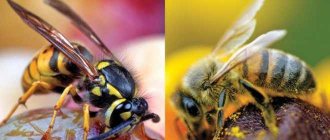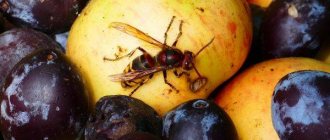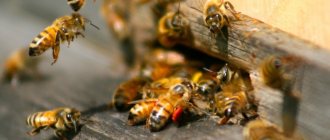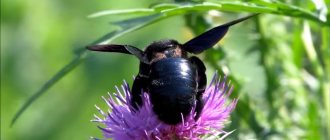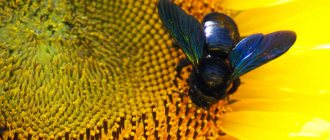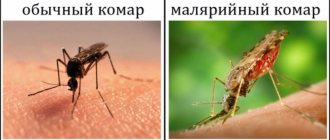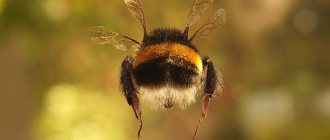When going on holiday outside the city in the summer, there is a high probability of encountering stinging insects. “Minke whales” are especially annoying when there are sweet dishes on the table. And when trying to drive away the “uninvited guest,” the insect can take revenge on the offender by inflicting a painful bite. Sometimes such attacks can be quite dangerous. It all depends on whose attention the sweet treat caught. Thus, honey producers are relatively friendly and attack humans only when threatened. Hornets and wasps are more aggressive in nature, so you should not neglect caution when meeting them. What is the difference between a wasp, a bee, a bumblebee, and a hornet, this article will help you understand.
Bee
Insects feed only on pollen and nectar and do this with the help of a long proboscis. The bee is calm and not aggressive in nature. It attacks only if there is a threat to life, if you press it by accident, it will bite, you won’t touch it, it will never attack itself. A bee lives for about a month, but if it bites, it dies immediately, because the sting, having notches, catches on the puncture and breaks off along with a piece of the bee's abdomen.
A bee sting is painful, but it can only sting once. Since insects die after being bitten, they sting only in exceptional cases. If we talk about the degree of pain, then, perhaps, a bee sting is less painful than that of a wasp or hornet.
What they look like
To determine whether a hornet is a wasp or a bee, you should pay attention to the appearance of the insects.
- The most discreet black and yellow color of bees. Their shaggy body is distinguished by harmonious proportions and the absence of sharp interceptions between the abdomen and chest. Honey producers have small jaws and black, relatively thick and hairy legs.
- The wasp can be recognized by the sharp transition between the thoracic and abdominal sections, as well as its smooth, thinner and elongated body. The insect is distinguished by a bright contrasting color: there are yellow blotches on the black back, the rear segment is painted with black and yellow stripes, and the limbs are yellow. The gnawing-licking type of mouthparts is distinguished by impressive mandibles.
- The bumblebee is much larger than its counterparts described above. The differences between a bumblebee and a bee and a wasp are not only in body size, but also in their furry cover. The bumblebee is also distinguished by wide stripes of yellow-red or slightly reddish color. Sometimes there are black bumblebees.
- The hornet is the largest (about 5 cm) of the insects described above and has powerful jaws. Externally, the giant resembles a wasp, but not with such a narrow waist.
Difference between bumblebee, hornet, wasp, bee
Bumblebee
The bumblebee and the bee are close relatives. Like bees, bumblebees are non-confrontational and attack only in exceptional cases, if there is no other option left. A bumblebee, unlike a bee, can sting many times, because bites of the insect itself do not cause any harm. But only females sting; males have genitals instead of stings, and their main purpose is to fertilize the uterus.
By the way, bumblebees and wasps are often at odds. Wasps rob bumblebee nests, eating supplies.
If we compare the stings produced by bumblebees and bees, the latter sting more painfully, and their venom is more toxic, besides, the bee's sting will have to be pulled out, but the bumblebee does not leave a sting.
On its own initiative, a bumblebee can bite in two situations:
- if the person's clothes are blue. For some reason, the blue color seems to be a threat to insects, and the bumblebee may behave inappropriately.
- if a person smells strongly of alcohol, tobacco or perfume. This could also be a reason for an attack.
Why don't mosquitoes bite everyone?
A good 20 percent of people are like honey for mosquitoes. Yes, yes, mosquitoes have clear preferences regarding whose blood they want . This must be a human victim with a pronounced characteristic odor. The individual odor arises from the fact that bacteria decompose human sweat. A certain combination of lactic, uric and fatty acids and ammonia truly drive mosquitoes crazy.
And for mosquitoes there is nothing more tempting than the smell of feet. They fly to foul-smelling feet with their rich and complex scent. In Tanzania, smelly socks are hung in front of the doors and windows of houses in an attempt to confuse malaria-carrying mosquitoes. And scientists are already working on creating mosquito traps with the aroma of “Eau de pieds” (foot perfume - French) to localize the spread of malaria.
There are a large number of components in human odor. It is not known exactly which scents are most loved by mosquitoes, but it has been established that, along with the smell of sweat, genes also play a role. Also, the smell of exhaled carbon dioxide, especially during exercise, is considered worthy of a bite by mosquitoes and they fly at it from a distance of up to 50 m. The smells of perfume, fabric softener, scented body lotions and shower gels also attract mosquitoes.
A special delicacy for them is people with the first blood group; They fly to them more often than others and bite. People say that they have sweet blood. And people with the second blood group , on the contrary, are much less attractive. Why this is so, no one can say for sure. The fact is that a chemical signal is formed on the human skin surface that tells flying bloodsuckers their blood type.
So the favorite delicacy of mosquitoes could be a smelling aftershave, a heavily sweating and heavily breathing athlete with blood type O and foul-smelling feet. And the absolute hit among mosquito delicacies could only be a pregnant woman doing sports, because her body temperature is elevated and she exhales even more carbon dioxide.
Wasp
Wasps are considered predators and aggressors and can sting just like that, depending on the mood. The wasp has a smooth sting that can pierce the skin several times. Unlike bees, a wasp can use not only a sting, but also a jaw apparatus, biting through the victim. If other individuals are nearby, they can smell the poison and join in the attack.
The painfulness of wasp stings can confidently be placed in third place, and wasp venom is very dangerous for a person who has diabetes of any type. It is said that angry wasps are more likely to attack those who are allergic to their stings. How they recognize this is unknown to science.
Habitat
The difference between a bumblebee, a hornet, a wasp, and a bee
It is clear that the place of residence for domestic bees is hives built by humans. Wild representatives of this family (wasps) prefer to build nests in tree hollows. Bumblebees look for more secluded places, building their homes in the ground, less often in birdhouses and tree trunks. Both are found in fields and villages; they can also be found in city parks and botanical gardens.
Hornets build nests in rock cracks, hollows and tree branches, as well as under the eaves of buildings. Almost everywhere they are built by wasps. The home of stinging insects can be located on the stems of plants, in the branches of bushes, and in the attics of bathhouses, sheds or verandas. By biting off pieces of fiber from wood, they moisten them with their saliva, as a result of which the building material becomes like thick paper.
Hornet
The most common representative of this family in Russia is the common hornet, reaching an average length of 4 cm. The hornet is considered the largest species among the hymenoptera insects. It stings when scared or angry; without a visible threat, it will not attack, but when defending the hive or its own life, it can go on the attack. Hornets jealously guard their home and can even make special sounds, warning their relatives of danger. Hornets can sting if you step on it or sit on it without noticing. Also, a hornet, like a wasp, can get into a person’s mouth along with a bitten piece of fruit or a sweet drink.
The hornet's sting is the most painful, as up to 2 mg of poison enters the wound of the victim. The hornet is endowed with the ability to attack its prey several times in a row, thereby inflicting multiple bites. The toxic substance causes burns, which is especially dangerous if the poison gets into the eyes and mucous membranes of a person. Since this insect eats waste protein foods and carrion, it, among other things, can be a carrier of infections.
What can you feel after a hornet bite?
- drop in blood pressure;
- dizziness;
- labored breathing;
- spasms of the gastrointestinal tract;
- disturbance and disappearance of the pulse;
- pain can last from a couple of minutes to several hours.
The danger of bee, wasp, bumblebee and hornet stings increases if a person exhibits allergy symptoms. If the victim is allergic, then after the bite you must immediately seek medical help, because an allergic reaction is one of the most life-threatening. In severe cases, extensive swelling, hives, vomiting, diarrhea, and an attack of suffocation may occur, which leads to anaphylactic shock.
If you have had an allergic reaction to a bee or wasp sting at least once in your life, then most likely the next time you bite it will be more pronounced.
Have you ever been bitten by a hornet?
Features of treatment of bites in children
Children who are stung are treated in the same way as adults: the wound is disinfected and a cooling compress is applied, anti-inflammatory and analgesic ointments, except hormonal ones, are used.
For wasp, hornet, and bumblebee bites, the child’s skin is lubricated with anti-inflammatory ointment 3 times a day
Then they carefully monitor the condition of the victim to see if an allergy has arisen - large swelling. In this case, an antihistamine is given in the pediatric dosages indicated in the instructions. If the baby’s condition does not improve within 1–2 days or the wound festers, you should visit a doctor.
Call an ambulance immediately if:
- a child under three months;
- the bite was on the neck, face;
- breathing is difficult, a whistle escapes from the throat;
- there is dizziness;
- coordination of movements is impaired;
- bites are numerous;
- pain in the heart area;
- the victim cannot speak or eat, which indicates swelling of the larynx.
If a child is bitten on the face, he needs urgent medical attention.
The risk group also includes children who suffer from diathesis, psoriasis, bronchial asthma and other diseases of an allergic nature.
A friend of mine was bitten on the tongue by a wasp as a child while he was eating a sandwich. It was on a remote sea beach, it took a long time to get to the doctors. A man standing nearby took an empty bottle and swam into the sea. The boy rinsed his mouth with the sea water he brought and the swelling of his tongue quickly went away.
If suddenly these stinging insects disappear
For several years now, environmentalists have been talking about a real and serious problem, which is a significant reduction in the number of bumblebee and bee colonies.
Perhaps, for many, the disappearance of these individuals would go unnoticed, because no one would miss, for example, a wasp that circles around a person who eats a watermelon. But in fact, not everything is as simple as it might seem at first glance, because they are very important for nature and bring great benefits.
The first thing to note is that these insects are constantly fighting pests, which is simply unnoticeable to an ordinary person, but at the same time, they can be said to protect the crop that a person collects.
And another very important and most important point is that they are pollinators of trees, shrubs and other plants, and millets do not exist in nature, so their disappearance will certainly affect human life and, unfortunately, not in the best way.
The best mosquito repellents
What can we do to prevent mosquitoes from using us as an all-you-can-eat buffet? The chemicals diethyltoluomide (DEET) and picaridin (icaridin or saltidin) are very effective; they repel mosquitoes (and ticks too) for six hours. However, DEET has an irritating effect on mucous membranes and the nervous system, so it is not recommended for young children and pregnant women. Picaridin is somewhat less aggressive, but still far from a biological substance.
Unfortunately, biomaterials are not the best alternative in this case, because they are much weaker than synthetic ones. They wear off quickly and need to be reapplied every two hours.
Biomaterials such as coconut oil, plant essential oils: citronellol, tea tree oil, extracts of lavender, eucalyptus, cloves, geranium, cedar, basil, garlic, peppermint - may smell unpleasant to the human nose, but they are not toxic. However, contact with some of these natural aromatic substances may well cause allergies. The body will be most reliably protected by a mechanical barrier: long clothes and mosquito nets.
What are the differences
Entomologists devote most of their lives to studying insects, so they can easily explain how a hornet or a bumblebee differs from a wasp. The difference between a hornet and a wasp is primarily in size. Hornets are the largest of all social wasps. A group of the Hymenoptera subfamily that uses paper to build nests.
But size is not the only difference between a hornet and a wasp. They also differ in pigmentation. Ordinary wasps have a classic yellow color, while hornets are darker, often brown. The caliber of the tip also differs. Although hornets have it the largest of the Hymenoptera, they use it much less often than wasps, since they are less aggressive.
